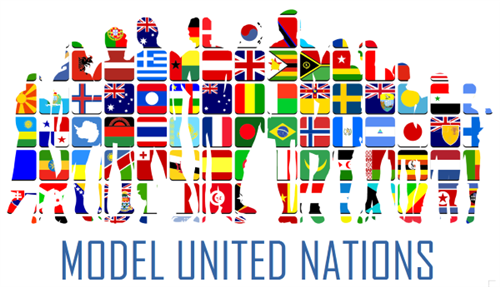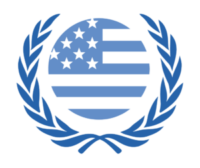
Frequently Asked Questions
Q: What is Model United Nations?
A: Model United Nations is a simulation of the UN General Assembly and other multilateral bodies. In Model UN, students step into the shoes of ambassadors from UN member states to debate current issues on the organization’s agenda. While playing their roles as ambassadors, student “delegates” make speeches, prepare draft resolutions, negotiate with allies and adversaries, resolve conflicts, and navigate the Model UN conference rules of procedure – all in the interest of mobilizing “international cooperation” to resolve problems that affect countries all over the world.
Before playing out their ambassadorial roles in a Model UN simulation, students research the issue that their committee will address. Model UN participants learn how the international community acts on its concerns about topics including peace and security, human rights, the environment, food and hunger, economic development and globalization.
Model UN delegates also look closely at the needs, goals and foreign policies of the countries they will represent at the event. The insights they gain from their exploration of history, geography, culture, economics and science contribute to the authenticity of the simulation when the role playing gets under way. The delegates’ in-depth knowledge of their countries guarantees a lively and memorable experience.
Q: How did Model UN begin?
A: While there is no official record of how Model UN began, we do know that Model UN is the successor of a series of student-led Model League of Nations simulations. Some people believe that the first Model UN conference was held at Harvard University, although other colleges claim they held the first conference. Regardless, simulations of international organizations began even before the birth of the United Nations!
Q: What is the relationship of UNA-USA to Model United Nations?
A: UNA-USA, a nonprofit, nonpartisan national organization with a network of more than 175 community-based chapters and divisions, has been a driving force behind Model UN education since the inception of its predecessor organization, the American Association for the United Nations, in 1943. Model UN is neither a UN nor a UNA creation, and it is not officially owned by any individual organization. The Model UN program in the United States is actually a decentralized community that is driven predominately by its student participants.
UNA-USA strives to as a clearing house for Model UN resources for participants and organizers. UNA-USA has created a library of Model UN publications including the Guide to Delegate Preparation, the Global Classrooms® Program curricular units, the Model UN for Everyone video and How to Plan a Model United Nations Conference. UNA-USA also hosts over 25 conferences a year in cities around the world.
Q: Who participates in Model United Nations?
- A: The popularity of Model UN continues to grow and more than 400,000 middle school, high school and college/university students worldwide participate every year.
Many of today’s leaders in law, government, business and the arts participated in Model UN during their academic careers:
● US Supreme Court Justice Stephen Breyer
● Former World Court Justice Stephen M. Schwebel
● ABC’s This Week anchor George Stephanopoulos
● Former first-daughter Chelsea Clinton
● Under-Secretary General for Public Information, Kiyotaka Akasaka
● UN Secretary-General, Ban Ki-Moon
● Actor Samuel L. Jackson
● Ryan Seacrest from American Idol.
● Rainn Wilson – Dwight from “The Office”
More recently, Model UN has been receiving attention in the mainstream media and has been featured in television programs including The Simpson’s, Like Family, Buffy the Vampire Slayer, Will and Grace, The OC, and Gossip Girl. Model UN was the theme of the Mary Kate and Ashley Olsen movie Winning London and mentioned in The Sure Thing and Along Came Polly. And at least one Jeopardy question was correctly answered with “What is Model UN?”
Q: What types of topics are discussed in Model UN conferences?
A: The agenda items discussed in committee vary at each conference. Most conferences tend to focus on current affairs issues that are being discussed in the United Nations. These issues can highlight political, financial and/or social concerns. However, the task of some committees might be to address hypothetical concerns or issues from the past or future. For example, many conferences have “crisis” committees, in which delegates must react to a hypothetical or actual crisis situation. Other conferences host historical or future Security Council simulations.
Q: What is a Model UN delegate?
A: A Model UN delegate is a student who assumes the role of an ambassador to the United Nations in a Model UN simulation. Prior to a conference or event, a Model UN delegate does not need extensive experience in international relations. Anyone can participate in Model UN, so long as they have the ambition to learn something new and to work with people to try and make a difference in the world. Model UN students tend to go on to become great leaders in politics, law, business, education and medicine, such as the people mentioned above.
Q: Why should I participate in Model UN?
A: Model UN promotes students’ and teachers’ interest in world around them and broadens a student’s knowledge in a variety of subjects. Model UN also teaches vital skills in negotiation, public speaking, problem solving, conflict resolution, research and communication. Model UN also gives students and teachers the opportunity to meet interesting new people and make new friends.
Q: What are some of the educational benefits of Model UN?
A: For almost 60 years, teachers and students have benefited from and enjoyed this interactive learning experience. It not only involves young people in the study and discussion of global issues, but also encourages the development of skills useful throughout their lives, such as research, writing, public speaking, problem solving, consensus building, conflict resolution and compromise and cooperation.

